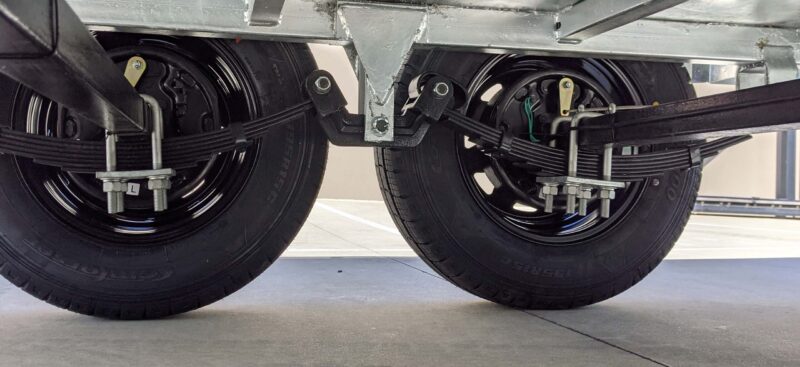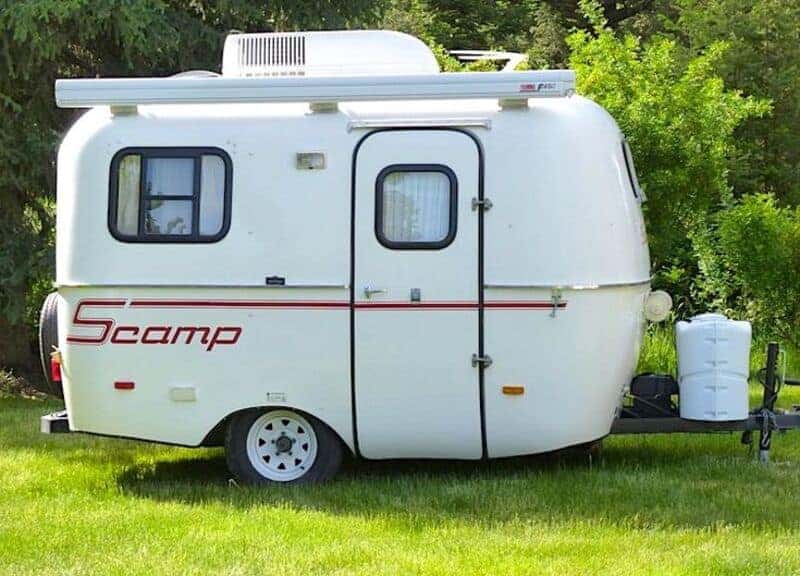Before and throughout the winter, travel trailer skirting becomes quite the commodity. Winter is an interesting conflict for RVers. While the world becomes blanketed in serene, white-crystal beauty, RVs turn into warm pockets of defense against the harshly cold elements.
Travel trailer skirting blocks winter breezes and gales from reaching beneath the RV, rapidly cooling the undercarriage and, eventually, seeping into your home. A cold undercarriage, combined with the inevitable seepage of warm air through the flooring, creates a determined, wintry intruder that’s difficult to keep out.
The best RV skirting does just that and, if you enjoy vacationing throughout the winter months, or are a full-time RVer, the inevitability of a solid RV skirt is paramount. This is especially true north of the Mason-Dixon line, where winters are crueler and longer.
What is Travel Trailer Skirting?
RV skirting is a material that surrounds and encapsulates the void beneath a travel trailer, balancing the interior temperatures within and combatting the elements without. They are typically made of vinyl, though foam board, canvas, plywood, and even metal are sometimes used.
It’s a winter upgrade, and its installation does more than just keep out the chilly winds. Skirting also drives down your power consumption via heating needs. Whether you’re running an electric RV furnace or strictly propane, it takes less power to heat the interior of an RV protected by skirting.
It also keeps out critters, who will happily seek out and target the warm pocket of your RV to escape the winter elements. It keeps your pipes from freezing, protecting your undercarriage from the sub-freezing temperatures that a fierce wind will only exacerbate.
However, as much as travel trailer skirting improves quality of life in the winter, it also has uses in the summer. Again, it keeps out the critters and the bugs, both of which are far more numerous in the spring and summer months. It also protects the RV from heat and sunlight in the summer, creating a sort of shady interior beneath your RV that contributes to your cooling needs.
Admittedly, RV skirting is nowhere near as predominant in the summer as it is in the winter, though it still has its uses in the former.
Does Travel Trailer Skirting Work?
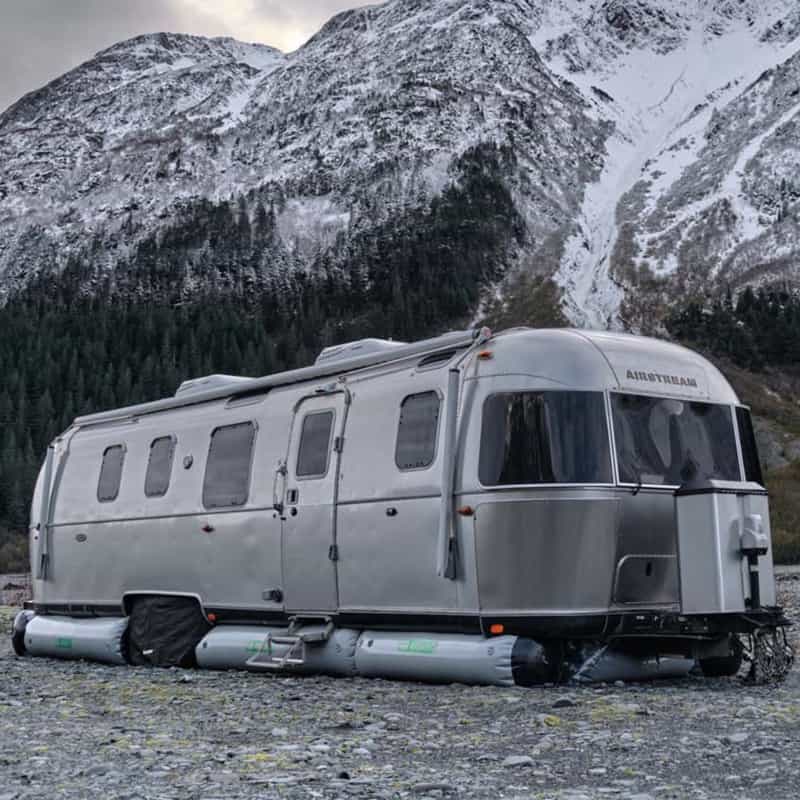
Travel trailer skirting works very well, which is why it’s a popular option among RVers, especially those who live in their RVs all year round. Skirting is simplistic in design and function, which makes it questionable as a functioning asset. Oftentimes, however, simplicity is best.
All the skirting needs to do is keep out the cold air while retaining the lost heat from within the RV, all in one big, happy bubble. Since heat rises, having a warmer undercarriage is highly beneficial and your furnace would thank you profusely, assuming it had a mouth to do so.
After all, we build walls to protect us from the elements, both natural and man-made, and skirting is nothing if not the same from a conceptual perspective.
That heat bubble may not be as warm as the interior of your RV, but it’s more than enough to aid your temperature controls and keep your tanks and pipes from freezing, all while keeping the local family of mice from seeking refuge beneath your flooring.
It even helps RVs with enclosed, heated underbellies. While the heated undercarriage may not freeze, unless you’re parked somewhere in North Minnesota or Alaska, the skirting adds another layer of heating assistance to your existing system. Again, this drives down the overall cost of heating.
If you’re still on the fence, purchase enough insulated foam board for a DIY skirting project. You don’t have to go wild with expense here, just enough to see the difference.
The insulated foam board will offer enough protection and reduced energy waste to convince you to pick up a professionally manufactured version for next season.
What is the Best Travel Trailer Skirting for Winter?
The best travel trailer skirting for winter will always be one of those controversial topics within RVer circles. We all have our personal preferences, and it’s hard to imagine ourselves choosing the lesser RV skirting. Well, that’s what articles like these are for.
Besides, the best of the best might not always be what everyone thinks it is. Especially when it comes to number three (which might be a surprise to some).
The good news is, that these RV skirting manufacturers are well-known entities in RV circles. They’re well-known because they produce effective travel trailer skirting with plenty of longevity.
Our Pick For Best Travel Trailer Skirting: AirSkirts
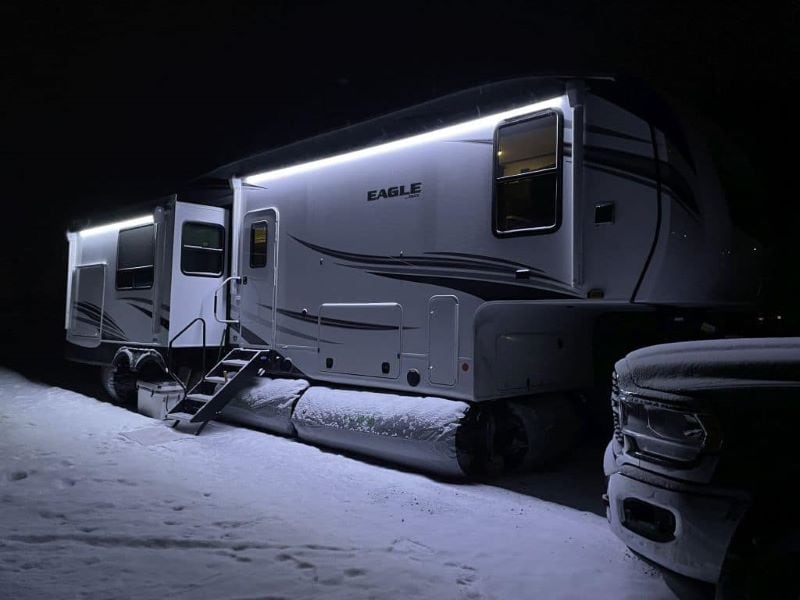
Our Pros and Cons
| Pros | 30-minute set-up time |
|---|---|
| 30-minute set up time | AirSkirts is a pricey product |
| Has immense aesthetic appeal | Can be difficult to skirt slide-outs |
| Doesn’t require installation | |
| Comes with a carry bag for storage and transportation | |
| Comes with an 800W air pump | |
| Customized to the dimensions of your rig | |
| Includes a 5-year warranty | |
| Creates an airtight seal for excellent insulation |
One of the biggest upsides to AirSkirts is its simplicity. AirSkirts advertises its product as a simpler application than any DIY travel trailer skirting project. The surprising thing about AirSkirts is how well-known they are, despite barely being three years old as a company.
That’s right, AirSkirts hit the retail market in 2020. In fact, the company was founded in January 2020, already making massive headway into the RV skirting market. The product became this way thanks to a cost-effective and relatively innovative setup, along with a high degree of durability.
There’s no getting around the fact that purchasing AirSkirts is a pricey proposition. They aren’t cheap by any means. However, you don’t have to have your rig professionally measured and you don’t need professional installation. AirSkirts pricing is comparable to a professional installation.
You can be assured that with that higher price tag comes a very high-quality product that uses the best materials.
When you purchase an AirSkirts product, you provide the dimensions, along with your rig type and your ground clearance. Once you have the product in hand, you’re looking at 15 to 30 minutes of installation time, and you’re done.
Check out this video below, where Mike from RVBlogger shows you how he installs AirSkirts on his Class C RV in just under 15 minutes! And he and Susan do a temperature test to show you how well AirSkirts works.
Another Great Travel Trailer Skirting Option: EZ Snap
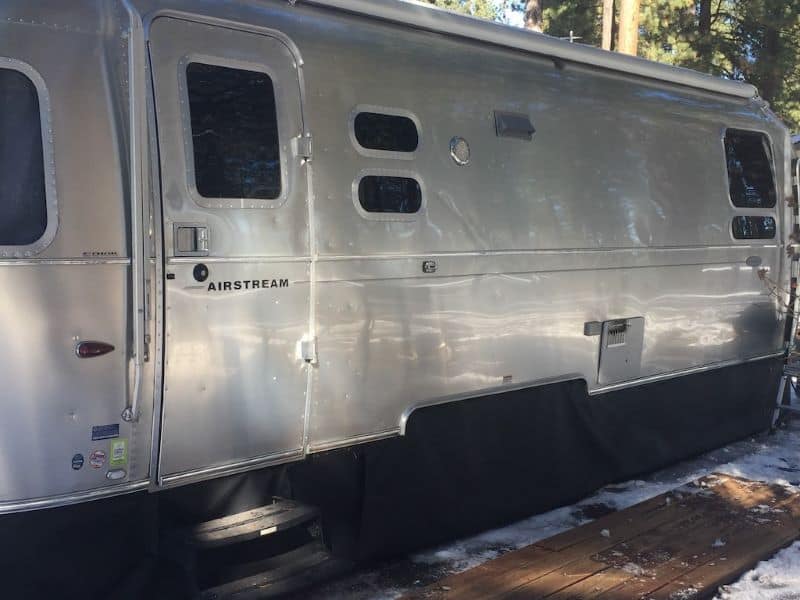
Our Pros and Cons
| Pros | Cons |
|---|---|
| Three hanging hardware options to choose from | Like the AirSkirts option above, EZ Snap is a very pricey insulation alternative |
| No need for a professional install | |
| Company sends vinyl rolls and hardware based on your provided dimensions | |
| Diamond weave RV Skirting | |
| Fabric is designed to resist fraying | |
| -40 °F cold weather rating | |
| Designed to cut and shape to your RV | |
| No-Drill fastening system |
EZ Snap is one of the most popular travel trailer skirting options on the market today. They’re easy to order and the DIY installation process is fantastic. All you have to do is provide EZ Snap with the dimensions and clearance of your RV, and they will send all the materials you require.
Not only do you get the vinyl, but you also get all the mounting hardware. In terms of hardware, you have several options, with adhesive and snap-on options being the most popular of the installation methods.
EZ Snap’s vinyl sheets are manufactured using EZ Snap’s diamond weave technology, which is designed for a number of things other than durability (though they are incredibly durable). Diamond weave vinyl from EZ Snap is designed so you can easily cut the fabric to length. You don’t have to hem the cuts, either, as the material will not fray.
The order process is very simple, and you can have someone come out and measure if you want (though you don’t even have to wait for them to start the installation process yourself). All-in-all, EZ Snap is a top, go-to RV skirting manufacturer that produces high-quality skirting you can depend on throughout the winter.
DIY Options For Travel Trailer Skirting
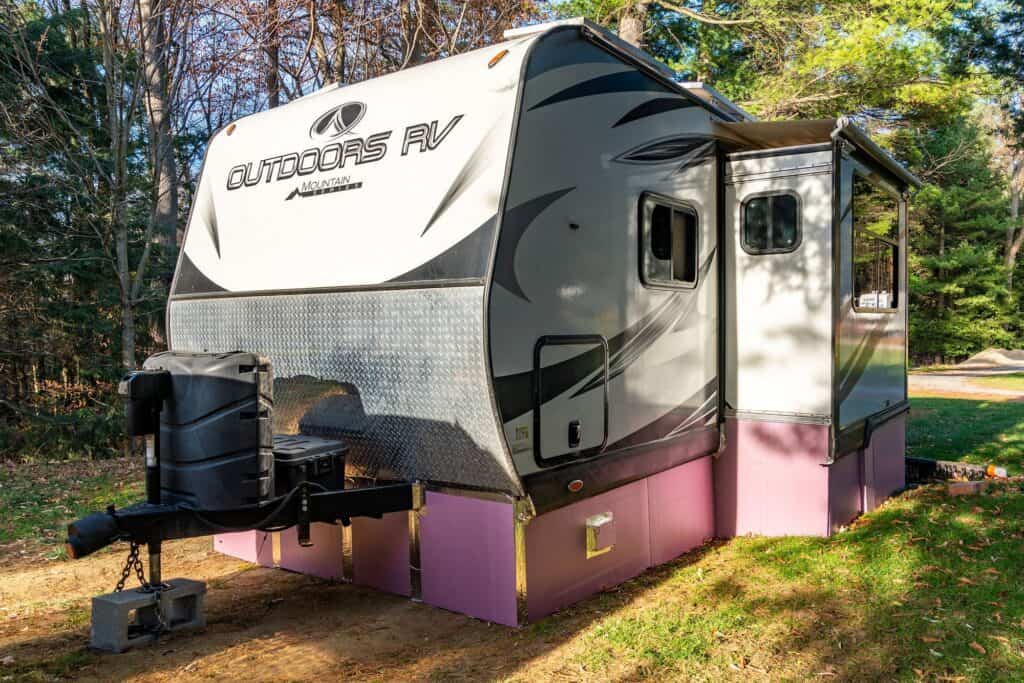
Our Pros and Cons
| Pros | Cons |
|---|---|
| It’s a very cost-effective option | It’s easier to make a mistake if you don’t know what you’re doing |
| Your choice of materials | |
| Your choice of overall costs | |
| You can install it on your own initiative | |
| You don’t have to deal with the go-between of customer service | |
| It’s easier to prep your own materials for hookups | |
| Experimentation is a good learning experience |
Travel trailer skirting doesn’t have to be something you purchase, ready-made, from a business.
You’re perfectly capable of doing the entire thing yourself. As long as you know what your options are and how to install it. There are also a number of materials that work well.
- Insulated foam board
- Vinyl
- Wood boards (Permanence)
- Metal (Permanence)
- Heavy-duty canvas
- Plastic sheeting or tarp
- Hay bales (Permanence)
As you can see, some of the above options are meant for RVs that aren’t going anywhere anytime soon. Out of the others, insulated foam board is probably the most popular. With foam board, you can insulate a fairly large RV without spending more than $200.
When you compare $200 and a little extra elbow grease over the $1,000+ it takes to purchase some RV skirting from a reputable manufacturer, you can see the appeal of the DIY option.
Do You Really Need Travel Trailer Skirting?
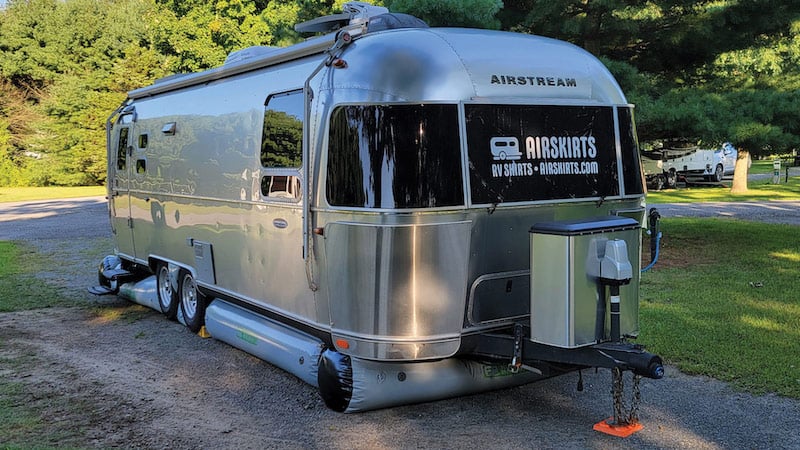
If you plan on spending time camping in the winter, especially in weather that easily drops below freezing, you need RV skirting.
Full-time RVers will appreciate the year-round benefits of both cold and warm weather insulation along with the hidden storage.
5 Advantages Of Travel Trailer Skirting
We’ve covered the things that RV skirting brings to the table sporadically above. However, if you’re new to the RV lifestyle and plan on camping in the dead of winter, you may need some reassurance that RV skirting is necessary.
1. RV Skirting Protects Your Pipes and Tanks From Freezing
One of the major benefits of RV skirting is this, right here. Frozen tanks or pipes are never a good thing, and there’s a good chance it will cause permanent damage.
Serious replacement or repairs to your pipe system or tanks will make that $1,000 cost for RV skirting look like an easy trip to the convenience store.
Of course, frozen pipes will also place you in a difficult situation, with no water flow. This is a bad position to be in, with toilets you can’t flush, no running water, no cleaning dishes, and no laundry (if applicable in your travel trailer). It’s not a situation you want to be in.
For more info about adding heating pads to your tanks, check out our article on MotorhomeFAQs.com called When to Turn on Your RV Tank Heaters.
2. Protects Your Tires
We didn’t list this one above but stable temperatures and no UV exposure is beneficial to your RV’s tires and travel trailer skirting can provide both.
3. Saves Money on Propane or Power Costs
Most RVers rock a propane-powered furnace but there are electrical alternatives as well. However, there’s no arguing that heating costs rise exponentially if you are consistently fighting below-freezing temps.
If you’re using propane, you’ll burn through it like crazy. A winter spent RVing will leave you with a large propane bill and lots of hours on your hard-working furnace. Investing in skirting can offset these costs greatly.
4. Keeps You Warmer and More Comfortable
Heat rises, and though the bottom of your RV, outside, is colder than it is inside, it’s much less so when you have RV skirting on. That makes it easier for you to keep your travel trailer’s interior warmer, since the heat loss in the floor is contained, keeping the floor warmer.
Cold-weather camping can be enjoyable if you’re prepared and have your RV insulated properly. Skirting is, without a doubt, the key component to comfortable cold-weather camping.
5. It’s a Good Storage Option
Travel trailer skirting is effective enough that you can use space below your undercarriage as a temporary storage option.
The RV skirting will help keep out bothersome critters and rodents, so your stored things will be protected from both the elements and the curious rummaging of a cold mouse.
How Much Does Travel Trailer Skirting Cost?
On average, expect to pay about $1,000, with prices potentially as low as $800 and as high as $3,500. However, if you decide to make it a DIY project, you will lower your cost by a lot. A solid, DIY travel trailer skirting project will cost as little as $100 and as much as $250.
That makes the latter option a highly respected and viable alternative to seeking out RV skirting manufacturers. That’s not to say that it’s a better option than the more expensive, professional alternatives.
In fact, companies like EZ Snap and AirSkirts will provide you with precision and more longevity than you’re likely to get with a DIY option.
How to Measure for Travel Trailer Skirting
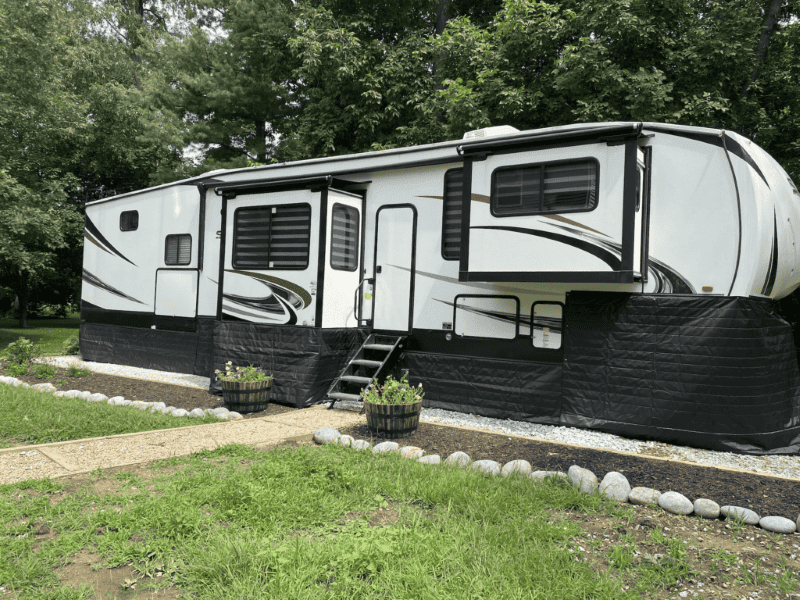
Two things you should remember when measuring for RV skirting: The overhang section of a fifth wheel needs to be enclosed as well and always measure your slides to include in your overall dimensions.
Make your way around the RV, measuring as accurately as possible. If you lack a tape measure long enough to provide you with measurements on the lengthier portions, bring along a helper to mark your positions.
Make sure your slides are out and you measure them accordingly. After you get your 2D measurements, it’s time to go 3D and measure out your clearance (Bottom of your RV to the ground). Be sure to include the fifth wheel overhang if that’s applicable.
In fact, you can square off the entire overhang section and treat it as its own block, adding it to the overall dimensions when you’re done.
Make sure you write all of it down, including the associated sections you measure. Also, it’s always a good idea to do it again, just to make sure. Once you call it in, any mistakes are too little too late. Fortunately, most RV skirting manufacturers supply a little extra on the material side.
5 FAQs About Travel Trailer Skirting
1. Does travel trailer skirting work?
Travel trailer skirting definitely works. So long as you use material with insulative properties and cover the entire clearance beneath your RV. It will retain heat and prevent cold air from freezing your pipes and tanks.
2. How does RV skirting work?
As insulation, it stabilizes the air trapped beneath the RV, preventing the outside air from cooling the clearance space below the travel trailer. It also retains heat loss from the interior of the RV as it seeps through the floors.
3. How do I know how much I need?
By properly measuring the dimensions of your RV, including slides, clearance, and fifth-wheel overhang (if applicable), you will be able to accurately determine how much RV skirting you need. However, it’s always best to err on the side of larger dimensions.
4. What type of travel trailer skirting material is best?
The type of travel trailer skirting that’s best is a close gamble between insulated foam board and vinyl that’s manufactured specifically for RV skirting. Any material that reduces the wind tunnel created by the RV’s clearance helps.
The most important thing is to use quality materials that will hold up. One of our cons on the Airskirts skirting system above was how heavy it is when packed up, well that’s because the vinyl used is thick and of the highest quality.
5. Is it worth the cost?
It’s absolutely worth the cost, considering the damage that freezing weather could cause to your plumbing system and your tanks. Damage to either has the cost potential to eclipse even the most superior, premium RV skirting materials on the market.
Final Thoughts About Travel Trailer Skirting
Unless you are a part-time, summer-only RVer, travel trailer skirting is an essential addition to your RV gear. Consider it a part of your preparation methodology—a necessary component forever on stand-by for those cold, winter months.
It’s so much better knowing you can go outside and enjoy the winter landscape and possibly build a snowman without worrying over the damage that an unprotected undercarriage will possibly cause.
Do yourself a favor. An RV is an enormous investment and, like any major investment in your life, it should be protected. Install your RV skirting, then go inside and have a cup of hot cocoa. Your RV is good to go and so are you.
Related Reading:
1. How To Insulate An RV Underbelly
2. How Many Gallons Are in a 30-lb RV Propane Tank?
3. 8 Best Travel Trailers Without Slideouts
4. 10 Things to Know About RV Window Replacement
5. Are Indoor RV Storage Facilities Worth It?
About the Author:
Thomas Godwin is a full-time freelance writer with a BFA in Creative Writing, a U.S. Marine, and an avid outdoorsman.
When he’s not writing, he’s raising chickens and Appleyard ducks. Thomas also constructs teardrop campers (attempting to anyway) and kayaks the Blackwater River with his wife, two daughters, and his Dobermans.



